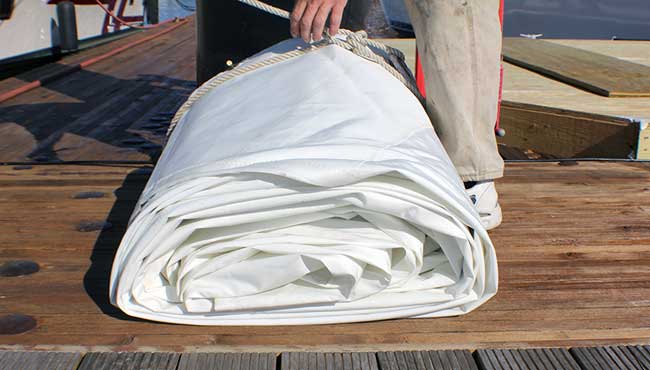
Remove sails from boat – Don’t leave them on boom/furling system all winter. Leaving the sails exposed to the elements is a sure way of shortening their life.
Inspect the sails for minor damage as you are removing them.
Mainsail – Look for broken luff slides and shackles, worn webbing, loose or worn stitching, broken or missing battens, torn batten pockets, luff or reef midpoint grommets that are pulling out. When checking over the stitching, look closely at the seams, particularly near the head, clew and leech. Also check the leech tape and leechline for wear and chafe. Also check the zippers, twists, windows, and ties on your sail cover, dodger and bimini.
Headsails – Check all seams, leech line and foot line cleats, hanks and luff grommets, tack, head, and clew rings. Check the top of the luff tapes for wear, and look closely at stitching on the UV cover if you sail is fitted for roller furling. Check for weakened or worn cloth where the sail chafes on the spreaders or mast light.
Sail washing – The biggest need for sail washing is to get salt out of the seams and fabric if the boat has been in salt water. Most of the time sails used in fresh water do not need cleaning. Any old mildew, grease, or blood stains that are on the sail will probably not come off without the use of harsh chemicals. If the stains are recent, try the following:
– use a degreaser for petroleum based products.
– use hydrogen peroxide may remove blood stains.
– use a solution of water, mild (non-detergent) soap, and a 1% solution of bleach for mold and mildew.
Scrub and rinse thoroughly, air dry. Do not use a laundry dryer to dry the sails.
Sail repairs – If you do find any minor repair work to be done, take care of it in the fall. Your sailmaker will appreciate bringing the sail in during the off season, and the sails will be ready to go in the spring when you are! You’ll also save yourself some money if you make a small sketch of the sail and identify exactly what needs repair. This is particularly true with spinnakers where small tears can be hard to find.
For final winter storage – make sure the sails are dry, fold or roll neatly, and store in a dry place.